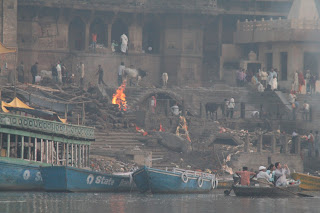Originally Written October 2015
The Ganges River, or the Ganga in Hindu, is a 2500km river that flows from the Himalayas, through India and Bangladesh and empties into the Bay of Bengal. It is the third largest river in the world by discharge, the Saint Lawrence is 14th and the Mississippi 15th for comparison.
The Ganges is the most sacred river to the Hindu Religion and is often referred to as The Mother River. It is a lifeline to millions of Indians that live along it and depend on it for daily life needs. The river provides irrigation water for agricultural through the use of dams and canals.
It is home to some 140 fish species, 90 amphibian species and the Ganges River Dolphin, all of which are under threat due to the extensive pollution of the Ganges, the fifth most polluted river in the world.
 |
Daybreak on the Ganges at Varanasi
|
The river is sacred to Hindus throughout its length, they bath in it to pay homage to their ancestors, the offer flowers, and light candles to it and all the cremated ashes of family members are brought to the Ganges or a tributary river and placed in the water for rebirth. Only in the Ganges can salvation be found, hence the need for ones ashes to be put into the Ganges or to be transported to the Ganges through other tributaries. The cost of putting a loved one into the Ganges is not a consideration at the time.
Although there are a number of Hindu holy sites in India, the city of Varanasi is by far the most referred and the spiritual capital of India. One of the oldest cities in the world, habitation began here between 3000 and 5000 years ago, Varanasi was an important industrial centre, dealing in muslin, silk, perfumes, ivory and sculpture.
It is believed that Buddha founded Buddhism here around 528BC, and since then Varanasi has grown in religious stature to become the spiritual site of today.
 |
| Pilgrims on the Ganges |
Varanasi has 87 Ghats, embankments made of steps of stone slabs where the pilgrims perform ceremonies and use to access the river.
Some Ghats are used exclusively for cremation, as all Hindus are to be cremated within 24 hours after death. Many of the villages and towns that surround Varanasi will transport the dead bodies to the Ghats for cremation, as the second closest way to salvation, is to be cremated in Varanasi and have the ashes enter the Ganges there.
 |
| Directions to a Ghat |
 |
| Cremation on the Ganges |

No comments:
Post a Comment